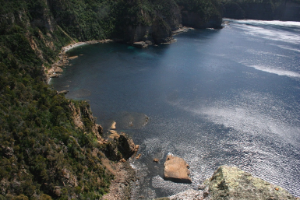- CCT Public Page
- [CCT Members Area]
Walter's Opening to Deep Glen Bay
The is the quintessential coastal traverse: challenging, committing and varied (with at least four major rock types), with an unusually strong sense of adventure and the unknown.
Due to the length of the traverse, the difficulty of escape and the exposed nature of the coast, this traverse really deserves respect and care. It may be possible to escape in one or two places, but even when there is no cliff, the land is extremely steep and the bush is sometimes very dense.
Drive to the car park for the walk to Cape Surville. The walk from here to Cape Surville is highly recommended in its own right, and a good way to get an impression of the first half of the traverse. It is immediately clear that the coast is extremely cliffy, and access to the water's edge is difficult. From the car park, head north down to the creek bed of Chasm Creek, then follow this (an interesting sunken corridor) down to the "chasm": a deep cleft in the cliffline into which the faint creek tumbles: this area is marked as Walter's Opening on some maps.
Our first attempt was aborted just after this this point. The swell was too big and we had a serious scare when cornered by a large wave while inside a nearby cave (method of survival: "hang on very tight" seemed to work on this occasion).
The second attempt was made on a day in November with a forecast of 15 degrees, showers and possible highland snow. We started at dawn, with mostly clear skies and low swells.
Initially the rock is a kind of mudstone perhaps: certainly it is quite loose, though at water level it is polished and even provides occassional short overhanging sections. The climbing is mostly short and scattered in this section, but the coastline is interesting, with some large caverns and hidden coves: a particularly striking arch is encountered shortly before the bay starting Cape Surville (see pictures). There are some short swims required.
By the time the start of Cape Surville is reached, the rock has turned to dolerite, and there are some lengthy sections of moderately easy climbing (with some very short swims) on typical good quality coastal Tasmanian dolerite. The point of Cape Serville itself is quite impressive, with some daunting dolerite caves capped by a some kind of very crumbly sedimentary rock/soil. The cliffs are probably over a hundred metres at their highest. Some moderate swims are required to pass the caves.
At Deep Glen Bluff the rock makes a dramatically sudden change to granite: the southern most section of granite on mainland Tasmania. The bluff itself continues for a long way, and presents some of the longest unbroken pieces of coastal traversing I've done. In many places, the soils above the cliff seem to have leached a layer of what looks to be classic smooth limestone over the granite. At one point this completely takes over, with no sign of the granite beneath. One section of rock offers consistent climbing on pristine granite/limestone at around grade 15 to 17 for hundreds of metres without break.
When the bay of Deep Glen Bay is reached, the granite takes on a different kind of character, presenting a series of sharp ribs of rock that force many short swims. Around 7 were needed within the bay itself. This was particularly memorable on the successful traverse, as rounding the corner to the bay (which is, ahem, deep) presented us with a biting southerly wind with blasting showers. The base of Deep Glen Bay itself has amazing character and presence (as well some historical interest) and is a fitting place to finish this brilliant traverse.
The adventure is not yet over however: the car is now some distance away. There is a faint track up the gully leading to Deep Glen Bay: this is very steep, but filled with beautiful forest of giant ferns, and some enormous Eucalyptus Globulus toward the top. At the top, a fire trail is reached. Head rightwards and then down another track that heads roughly northward back toward Cape Surville. Follow the Cape Surville track back to the car. The walk to Deep Glen Bay is described in several walking books, and it would be worthwhile investigating these first.
This round trip took a full morning: around 7AM to 1:30PM; we went fairly fast, doing a fast jog for the walk back.

|

|
|
The section north of Cape Surville: we emerged from within the cave in the middle left of the picture (the "arch" described in the traverse description).
|
Beautiful easy bay between the cave and Cape Surville.
|

|

|
|
From the top of Cape Surville looking north. The start at chasm creek is out of view to the right of picture.
|
The northern side of Cape Surville offers a reasonably extended section of dolerite climbing above water. The rock is also dolerite on the southern side, but the coast is pockmarked with several very dramatically imposing caves.
|

|
|
|
The Sisters, off the northern corner of Deep Glen Bluff. There is a very dramatic change from dolerite to granite here (at the enormous diagonal stripe; with a kind of crumbly mudstone/limestone on the hill above). The longest sections of climbing are s
|
